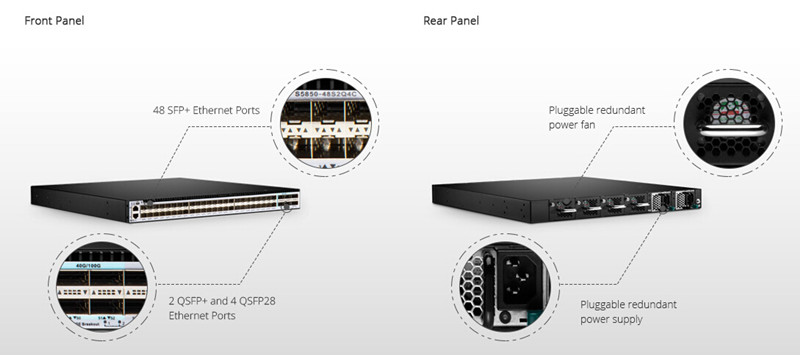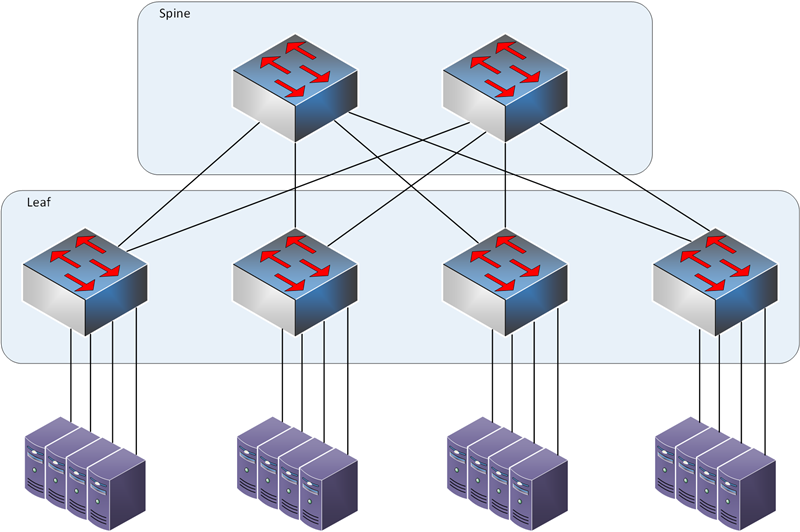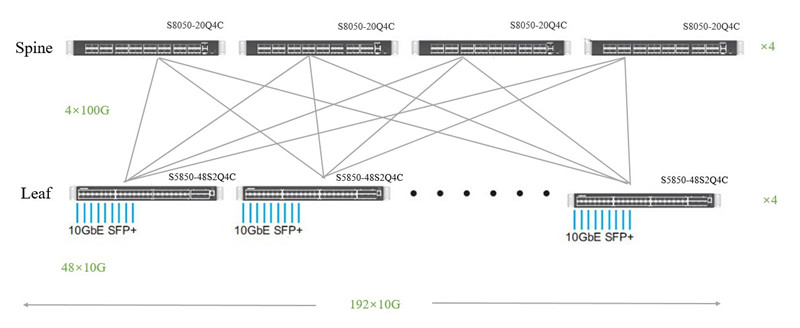Data centers nowadays are not just getting greener – they’re becoming less expensive. Until recently, we have witnessed a dramatic growth in sales of 10GE Ethernet switches as price comes down. As the demand for switching capacity keeps accelerating, a strong migration to higher Ethernet speeds in thus inevitable. 10GE SFP+ switch deployment lies the very foundation of data center expansion, serving as the building block at the edge of data center or as a leaf switch in the new “leaf-spine” fabric. A 48-port 10GE switch offers optimal port density and scalability potential for a relatively larger network. This post underlines the possible use of a 48-port 10G Ethernet switch and how to deploy it in a “leaf-spine” architecture.
Over more than a decade’s evolvement, 10G Ethernet is now well established as a stable, standards-based connectivity technology to efficiently handle and manage bandwidth-hungry data center applications. 10GE SFP+ switch, with huge cost-per-port reduction, along with the performance gains and energy efficiencies, portends a significant rise throughout data centers and networks. Meanwhile, 10G Ethernet switch boasts the scalability as a reliable upgrade and migration path to the higher-performance networks. Acting as a Top-of-Rack (ToR) switch for server aggregation at the edge of data center or a leaf switch to a more simplified “leaf spine” design, 10G Ethernet switch has become the choice of performance and network expansion.
The thirst for data is not going to fade, while network slowdown and outages have turned into top challenge for network administrators – which in turn speed up 10G Ethernet switch adoption. Being fully aware of the quest, FS.COM unveiled a 48-Port 10GE switch, designing to deliver 10 Gigabit Ethernet everywhere in the data center, metro and enterprise network. This S5850-48S2Q4C 48-Port 10GE switch has 48 10Gb ports and 6 40/100Gb uplink ports, delivering a whopping of 1.92Tbps switching capacity while offering flexible migration options. FS.COM 48-Port 10GE switch supports layer 2 and layer 3 switching and advancing features like MLAG, VXLAN, SFLOW, SNMP etc.

The port configuration of this 48-port 10GE switch shares much similarity with that of 10G switch Cisco Nexus 92160YC-X – a switch Cisco claims to designed specifically for growing data center requirements. Here we make a comparison of these 48-port 10GE switches.
|
FS.COM S5850-48S2Q4C
|
Cisco Nexus 92160YC-X
|
|
| 10G SFP+ Ports |
48
|
48
|
| 40G QSFP Ports |
6
|
6
|
| 100G QSFP28 Ports |
4
|
4
|
| Switching Capacity |
1.92Tbps
|
3.2Tbps
|
| Power Consumption |
160w
|
150w (10Gb)
|
| Switching Class |
Layer 2/3
|
Layer 2/3
|
| Price |
$6,899.00
|
$22,500.00
|
The difference between these two 10Gb switch is that the 48-port downlink ports on 10G switch Cisco 92160YC-X can be configured to either 1/10/25-Gbps ports. While it comes to the cost, the gap is rather huge, FS.COM 48-port 10 GE switch costs less than 1/3 of 10G switch Cisco 92160YC-X. So if you’re on a tight budget, and currently not plan to deploy 25G, FS.COM 48-port 10GE switch might be a more cost-friendly alternative.
“Leaf-spine” architecture (leaf/TOR-spine/core) has become a more popularized network fabric as data centers grows in scale: conventional three-tier model (top-of-rack/aggregation/core) is proven less efficient as servers multiplied. In a “Leaf-spine” design, every spine switch can connect to any leaf switch, connecting the leaf switches directly into the core of a network. The typical layout of this architecture is illustrates below. (Source from Cisco)

FS.COM 48-port 10GE switch is such a “leaf switch” in spine-leaf architecture – it aggregates traffic from server nodes and then connect to the spine switch. With this design, one can handle east-west traffic (from server to server) and north-south type alike, and to expand network quickly by add new leaf and spine switches without re-architecting it. With fewer tiers of switches, cabling is significantly simplified as well. With FS.COM 100G Ethernet switch S8050-20Q4C as spine switch, 48-port 10GbE switch S5850-48S2Q4C paves the way for migration to 100G network.

48-port 10GE Switch is well poised for an expanding role in data center applications, and the future of which is both agile and responsive in meeting business needs. With the expansion of the leaf-spine architecture and increased need to improve the efficiency and capacity of data centers, it is the right time to scale up your data center with an affordable 48-port 10GE switch.




